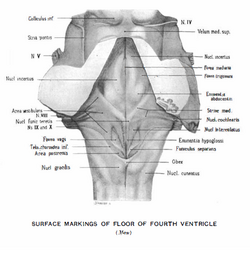Biology:Nucleus incertus
| Nucleus incertus | |
|---|---|
| Anatomical terms of neuroanatomy |
The nucleus incertus is a region of the pontine brainstem just ventral to the 4th ventricle.[1] The term was coined by George Streeter (Latin for "uncertain nucleus") based on its unknown function at the time, to name a group of cells he observed near the midline of the floor of the 4th ventricle.[2] It sometimes called the 'nucleus O'.[3]
The nucleus incertus is a bilateral structure which sits near the brainstem, in front of the nucleus prepositus hypoglossi.[4] It consists of mostly ascending GABAergic projection neurons and glutamatergic neurons[5] which innervate a broad range of forebrain regions involved in behavioural activation.
It is part of the theta network acting as a relay from the reticularis pontis oralis nucleus to the septo-hippocampal system.[6] The stimulation of the nucleus incertus activates the hippocampal theta rhythm and either its lesion or inhibition suppress the theta oscillation induced by brainstem stimulation.[7] The nucleus incertus itself presents theta oscillations coupled to the hippocampal theta rhythm.[8]
In addition to hippocampal theta rhythms, the nucleus incertus is involved in the control of locomotor speed and arousal,[9] response to stress[3] and intergrating the vestibulo-ocular reflex and gaze holding with hippocampal navigation.[6]
References
- ↑ "Connections of the nucleus incertus". The Journal of Comparative Neurology 438 (1): 86–122. September 2001. doi:10.1002/cne.1303. PMID 11503154.
- ↑ Streeter, George L. (1903). "Anatomy of the floor of the fourth ventricle. (The relations between the surface markings and the underlying structures.)". American Journal of Anatomy 2 (3): 299–313. doi:10.1002/aja.1000020303. ISSN 1553-0795. https://zenodo.org/record/1850276.
- ↑ 3.0 3.1 "Nucleus incertus--an emerging modulatory role in arousal, stress and memory". Neuroscience and Biobehavioral Reviews 35 (6): 1326–41. May 2011. doi:10.1016/j.neubiorev.2011.02.004. PMID 21329721.
- ↑ Cheron, Guy; Ris, Laurence; Cebolla, Ana Maria (2023). "Nucleus incertus provides eye velocity and position signals to the vestibulo-ocular cerebellum: a new perspective of the brainstem–cerebellum–hippocampus network". Frontiers in Systems Neuroscience 17. doi:10.3389/fnsys.2023.1180627. ISSN 1662-5137.
- ↑ "Glutamatergic projection from the nucleus incertus to the septohippocampal system". Neuroscience Letters 517 (2): 71–6. May 2012. doi:10.1016/j.neulet.2012.04.014. PMID 22521581.
- ↑ 6.0 6.1 "Anatomical evidence for a ponto-septal pathway via the nucleus incertus in the rat". Brain Research 1218: 87–96. July 2008. doi:10.1016/j.brainres.2008.04.022. PMID 18514169.
- ↑ "Nucleus incertus contribution to hippocampal theta rhythm generation". The European Journal of Neuroscience 23 (10): 2731–8. May 2006. doi:10.1111/j.1460-9568.2006.04797.x. PMID 16817876.
- ↑ "Theta synchronization between the hippocampus and the nucleus incertus in urethane-anesthetized rats". Experimental Brain Research 211 (2): 177–92. June 2011. doi:10.1007/s00221-011-2666-3. PMID 21479657.
- ↑ "Control of locomotor speed, arousal, and hippocampal theta rhythms by the nucleus incertus". Nature Communications 11 (1): 262. January 2020. doi:10.1038/s41467-019-14116-y. PMID 31937768. Bibcode: 2020NatCo..11..262L.
 |


